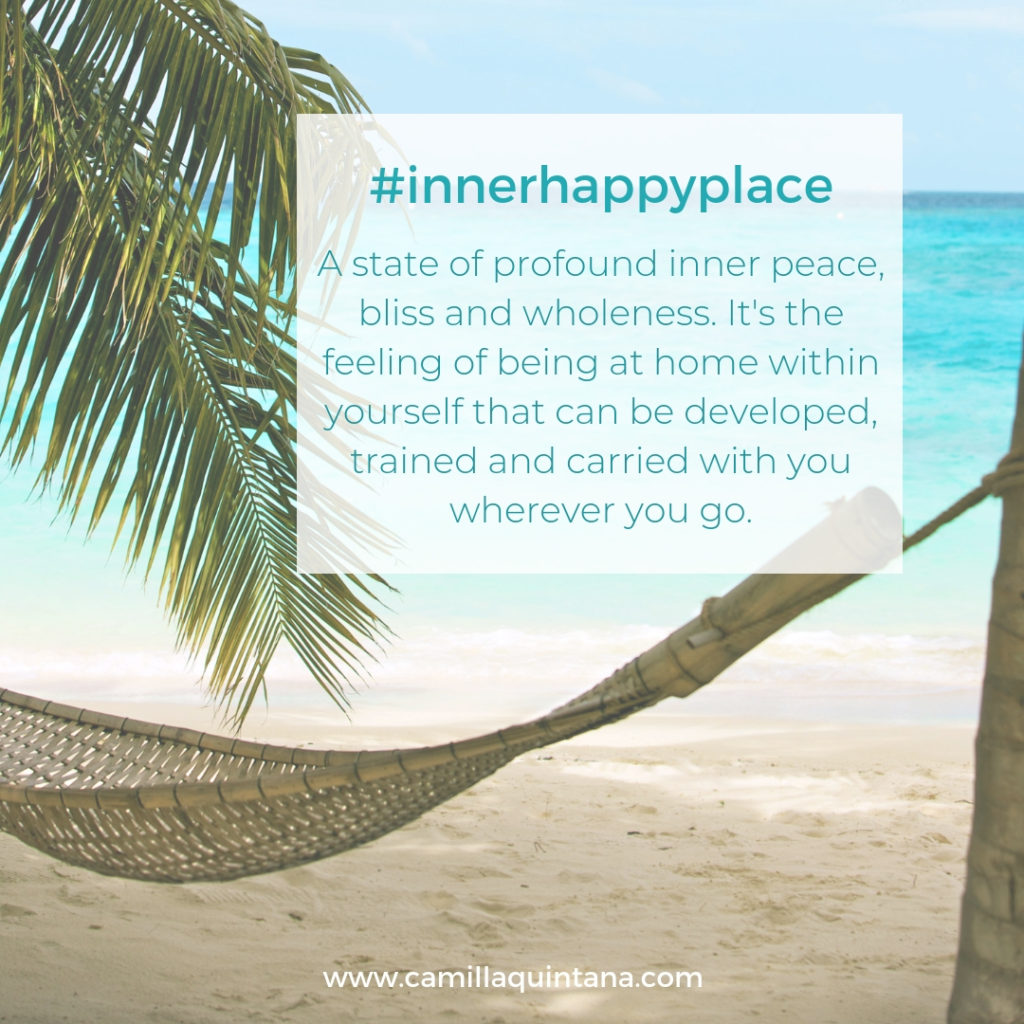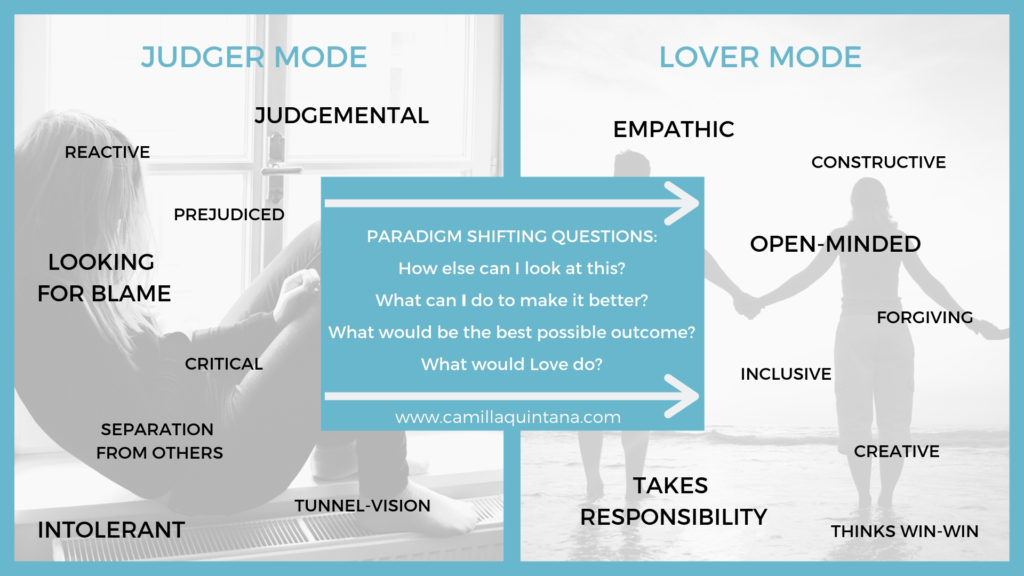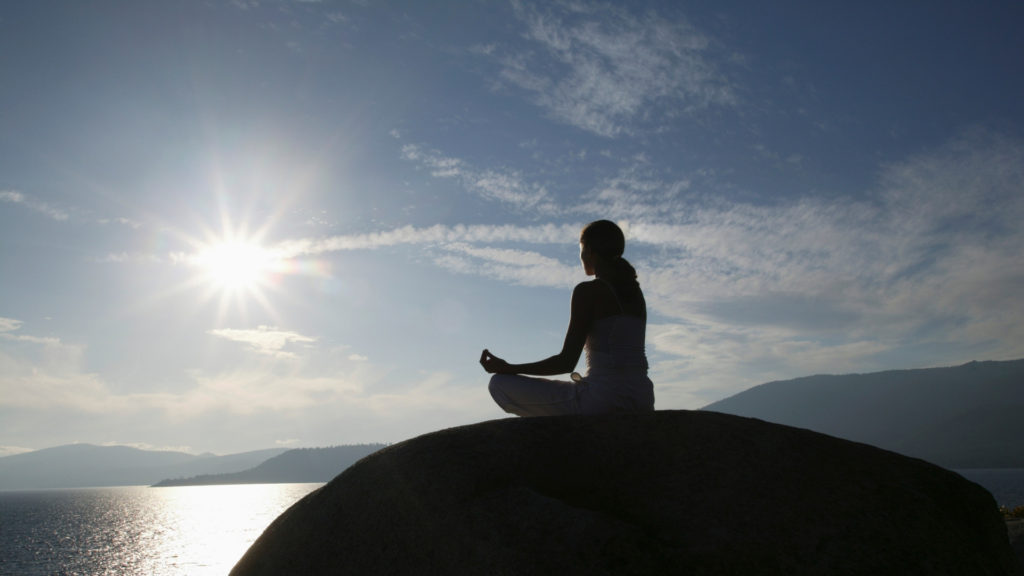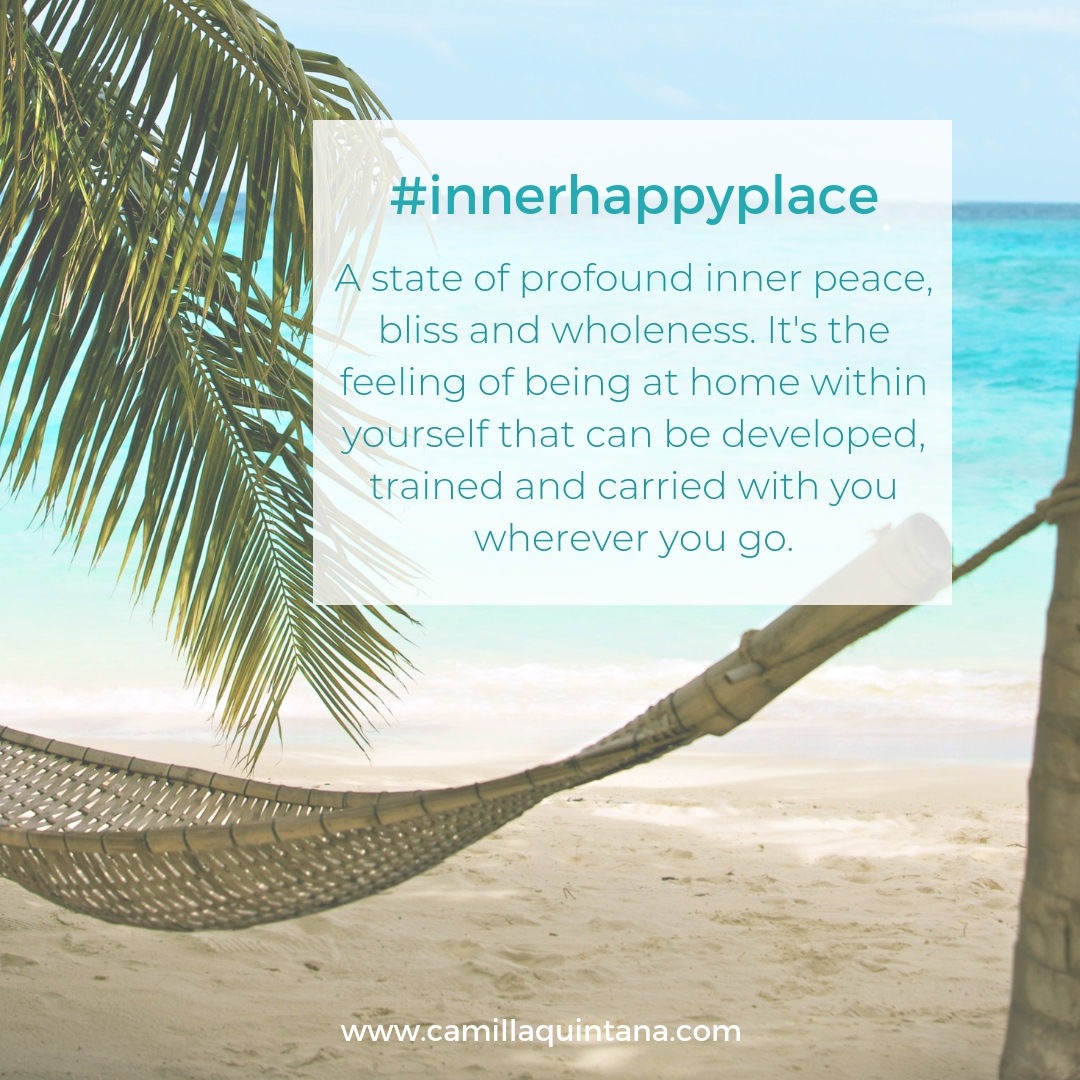7 Ways to Develop and Cultivate your “Inner Happy Place”
If you’ve been following me around, you’ll have come across this expression several times: “Inner Happy Place”… but what the heck does this mean?
Don’t worry, it’s a legitimate question. After all, I invented the term one afternoon in my living room back in Vienna/Austria, while I was video-calling my sister in Sydney.

At the time I was mentally preparing myself for (yet another) international relocation. Quite frankly, in the stage of my life I was in, this could have been really hard on me – everything indicated that it should be!
But I had made a determined decision to make the best of it. To see it as a blessing in disguise and an opportunity for growth. And once I made that decision there was no alternative way of being anymore.
In the months and years prior to this event, I had already committed myself to my own personal and spiritual development, applying many helpful tools I had learnt or come up with alonge the way. As I spent more and more time with myself and my mind, I noticed becoming more grounded within myself.
“You are already at home, within yourself”
Despite the upcoming move, that would mean: giving up my established career, saying goodbye to my family, friends and the home I felt so happy in, I was becoming more calm and peaceful inside. It was almost like something whispering from within me: “Don’t you worry. Everything is going to be alright. No matter where you go, you are already at home within yourself.”
And that’s what I was telling my sister on the phone when she asked me how I felt about our upcoming move. How I felt this deep connection to myself, this inner calm… like an internal, tight embrace. It felt so good, so empowering, so trustworthy and real: “I’ve found my inner happy place.”
And you can find yours, too. When you do, you’ll be able to meet whatever challenges and transitions you’re facing in your life from a place of internal stability, wholeness and consciousness. And even though you might lose it from time to time, you’ll be able to go back to that place. Because once you’ve found it, you can’t go back to not knowing it’s there. That’s the beauty of it.
In this post I want to share the 7 habits that helped me develop that state of mind:
1. Growing Self-Aware – the pathway to accessing your Inner Happy Place
Do you know who you are away from all the noise? Do you know what things really make you happy and what others trigger you to feel bad?

Knowing your authentic self is crucial. If you don’t, you might be living your life with shackles on your hands, which your culture, family, peers or society have imposed on you. You’ll act in a way and react to things without really understanding why. You might be sabotaging yourself – by procrastinating, making the wrong choice over and over again, by maintaining destructive habits – and not even realizing it. You follow the “rules” of others blindly, wondering why you feel so empty and lost inside. Why you can’t seem to live up to the expectations of others or why, if you do, it doesn’t fill you with joy.
It’s probably because you haven’t really gotten in touch with your authentic self. Coaching is an amazing way of becoming more self-aware and growing more connected. Getting to reflect deeply on things with the help of a professional who’ll ask you the right questions is priceless. Everyone should have a coach – I work with them, too!
As I always say, once you know something you can’t go back to not knowing. Investing in truly getting to know yourself is probably the most important thing you’ll ever do. And I promise you that it won’t only benefit yourself but also the way you show up, connect and contribute to each and every person around you!
2. Upgrade your Thoughts and Words
Thoughts are really just words we say to ourselves. And in case you didn’t know, any emotion is preceded by a thought, no matter how fleeting or unconscious. The things we say (think) to ourselves over and over again can actually have a hypnotic effect on us and become deeply ingrained in our subconsciousness. Furthermore, a simply thought can induce a biochemical reaction in our body.
So getting to know our thought patterns and upgrading them is a vital tool for self mastery! I have written about this extensively in another blog post: Change Your Words, Change Your Life – check it out!
3. Change the Storyline

The way we experience the world and any given situation feels so real to us. And yet, there are other people who look at the same world, the same situation or person – and have completely different thoughts about it! How can this be??
Fact is, there is no “reality”. Only the stories each and everyone tell ourselves about it. This stories are informed by the way we were raised, our many, different experiences, society, culture, religion etc. We tend to cling to our version of reality, because this gives us a feeling of safety and stability. And yet… it really is just a story. And therefore a choice in how we WANT to look at the world.
The scientific explanation behind this points to our brain’s reticular activating system (RAS). It is responsible for filtering what we focus on and for scanning our surroundings for proof that will validate what we already believe and anticipate.
That’s why, if you believe that others can’t be trusted, you’ll probably experience that they really can’t. Or if you believe that you’re never going to be successful, you’ll probably find plenty of ways to proof to you that you can’t. Quite certainly there are many things in your life that indicate the opposite, but it’s hard to see them when your brain is wired not to.
The problem is that we don’t notice our RAS in action. Our underlying beliefs, which it diligently seeks to validate, run on autopilot in our subconsciousness. Most limiting beliefs are formed in our childhood and are very likely to be simplified perceptions or even completely outdated protection mechanisms that we don’t need anymore as adults. But if we’re unaware of what’s happening, we’ll think that “this is simply the way it is”.
One tool that has helped me tremendously to overcome disempowering story-telling – and that I practice with my clients – is my Counter-Thought Exercise (read about it here). It’s a clever and fun way to break your patterns, to grow more resourceful and creative and start writing a much more empowering script for your life!
4. Gratitude
Oh gratitude… This really is one of the best habits you can possibly develop and once you do, you’ll never want to go without it.
There’s a real magic to acknowledging and appreciating things in your life on a regular basis – I encourage my clients to set triggers to remind them to give thanks. For instance, do you have a habit of pressing the Snooze Button when it’s time to get up in the morning? No worries, let me show you how to actually put this button to great use: in the minutes left until the next alarm goes of, think of a few things you’re grateful for – big and small. This is not only a healthy habit with a powerful ripple effect to be noticed within days – its also a great way to start the day!
Dr. David Hawkins was able to assign our emotions an energetic frequency and Gratitude is among the highest calibrating ones. That means that when you feel deeply grateful, your personal energetic frequency is highly elevated. You can’t be grateful and grumpy or mean at the same time, it doesn’t work.
5. Choosing Love over Judgement

In a I’ve introduced you to my model “Lover Mode” versus “Judger Mode”. When you’re in Lover Mode you’re open, constructive, resourceful and empathic. A great pre-requisite to come up with effective solutions to any challenge, to think outside the box, to be motivated and inspired.
On the other hand, when we’re in Judger Mode we’re crtitical, harsh, thinking in terms of blame, we’re intolerant and look at situations with a tunnel vision. We want to win and be right.
I’d like to take this concept a step further here and ask you this: Whenever you chose Judger over Lover Mode in the past, did you feel happier? Did it make you feel light, cheerful, free and expansive or rather heavy, grim and tensed? Did you feel more connected to yourself and others, or rather separate, scared to show your vulnerability, to loose your face or to trust others.
Could it be that we only think that we should adopt the Judger mindset in order to supposedly shield us from pain? But actually, the fact that we’re pulling away, judging and grudging is what’s causing us even more pain?
In my life, I certainly never regretted meeting people with love and kindness… I have regretted doing the opposite.
6. Growing your “Spiritual Muscles”
Whether you call yourself religious or spiritual… believing in a higher power can provide you with a lot of meaning and make you see life events as parts of a greater, spiritual journey.
Faith and spirituality have always been central to me. No matter your personal background and preferences, I’d like to encourage you to spend some time with this topic, reading religious or spiritual texts and noticing what touches your heart, what brings joy to your spirit and what you feel most drawn to.
Personally, I believe that the approach many people traditionally had to religion is outdated and very “human” – not “God-like”: using religion to separate from others, using it as an excuse to judge, criticise, even harm others, or to hide behind a wall of “morals” in order for their humanity and vulnerability not to show. This has got to be the last thing God desires.
Faith and spirituality can and shall make us feel so enriched, so loved, and so guided. Let’s make sure we keep it that way!
7. Meditation and Mindfulness:

You don’t have to sit in lotus pose for an hour in order to experience the benefits of meditation or mindfulness. Nowadays, there are great, short, guided meditations that can help you turn inwards and reap its benefits.
If meditating doesn’t “call out your name”, then try taking a few minutes from time to time to simply be mindful. To be fully present in the moment.
If you’re fully present in any situation in your life, you can give your mind a break from past events entering your thoughts, and the pain, anger or regret you may associate them with. Neither do you let the future step into it, in the form of stress, worry or anxiety. Give your full self and your attention to whatever it is you’re doing in that moment.
__________________________________
These were the seven habits and strategies I applied and that helped me unfold that beautiful state of mind I refer to as our inner happy place. It made such a big difference in my life and in the way I respond to challenges, and I’m certain it will do the same for you. Do let me know!
Update: Years after writing this post, the Elephant Journal published an article I wrote about my personal journey towards finding my Inner Happy Place. Read it here.



Nên kê máy giặt lại muốn tạo nên sự cân bởi. https://mangdichvu.net/san-pham/sua-may-giat-lg-uy-tin-chuyen-nghiep/
Hãy đóng góp nắp máy lại nhằm máy giặt hoạt động phổ biến. https://mangdichvu.net/may-giat-khong-vat-cach-sua-may-giat-khong-vat-aqua/
Xung khắc Phục: Gọi đến cty sửa trị. https://mangdichvu.net/sua-may-giat-samsung-tai-ha-noi/
ĐiỀU này thực hiện tăng nguy hại hỏng mạch
của sản phẩm giặt. https://mangdichvu.net/san-pham/sua-may-giat-electrolux-duoc-tin-dung-nhat/
Máy ko vắt được quần áo sau Khi giặt xong…. https://mangdichvu.net/cong-tac-cua-may-giat-cach-sua-cong-tac-cua-may-giat-panasonic/
Good post! We will be linking to this particularly great post on our website.
Keep up the good writing.
I am in fact delighted to glance at this blog posts which carries
tons of valuable information, thanks for providing such information.
A person essentially assist to make critically posts I’d state.
This is the very first time I frequented your web page
and so far? I surprised with the analysis you made to make this particular submit incredible.
Great activity!
Does your website have a contact page? I’m having problems
locating it but, I’d like to send you an email. I’ve got some creative ideas for your blog you might be interested in hearing.
Either way, great website and I look forward to seeing it grow over
time.
Hi mates, pleasant post and pleasant urging commented at this place, I am actually enjoying by these.
Helpful information. Fortunate me I discovered your web site unintentionally, and I
am stunned why this twist of fate didn’t came
about in advance! I bookmarked it.
Hiya! Quick question that’s totally off topic.
Do you know how to make your site mobile friendly?
My website looks weird when viewing from my iphone 4.
I’m trying to find a template or plugin that might be able
to correct this issue. If you have any recommendations, please share.
Appreciate it!
Hello, I enjoy reading all of your post. I like to write a little comment to
support you.
Hey! Do you know if they make any plugins to protect against hackers?
I’m kinda paranoid about losing everything I’ve worked hard on. Any recommendations?
It’s in fact very complicated in this full of activity life to listen news on Television, therefore I just use world wide web for that reason, and obtain the hottest news.
Greetings from Carolina! I’m bored to tears at work so I decided to check out
your website on my iphone during lunch break.
I love the info you provide here and can’t wait to take
a look when I get home. I’m amazed at how quick your blog loaded on my mobile ..
I’m not even using WIFI, just 3G .. Anyways, awesome site!
Today, I went to the beach front with my children. I found a sea shell and
gave it to my 4 year old daughter and said “You can hear the ocean if you put this to your ear.” She put the shell to her ear and screamed.
There was a hermit crab inside and it pinched her ear. She never wants to go back!
LoL I know this is entirely off topic but I had to tell someone!
We are a group of volunteers and starting a new scheme in our community.
Your site offered us with valuable information to
work on. You’ve done an impressive job and our whole community will be grateful to you.
I always used to study paragraph in news papers but now as I am a user
of net therefore from now I am using net for posts, thanks to web.
Hi there would you mind letting me know which
web host you’re using? I’ve loaded your blog in 3 different
web browsers and I must say this blog loads a lot quicker then most.
Can you recommend a good web hosting provider at a reasonable price?
Thanks a lot, I appreciate it!
Great beat ! I would like to apprentice whilst you amend
your website, how can i subscribe for a weblog site?
The account aided me a appropriate deal. I were
tiny bit familiar of this your broadcast offered vivid clear concept
Wow, superb blog structure! How long have you ever been blogging for?
you make running a blog look easy. The total look of your website is excellent, as neatly as the content material!
When I initially commented I clicked the “Notify me when new comments are added” checkbox and now each time a comment is added I get four emails
with the same comment. Is there any way you can remove
people from that service? Appreciate it!
I’m impressed, I have to admit. Rarely do I encounter a blog that’s equally educative and amusing, and without
a doubt, you’ve hit the nail on the head. The problem is something that not enough men and women are speaking intelligently about.
I am very happy that I came across this in my search for something relating to this.
What i do not realize is if truth be told how
you’re now not really a lot more well-preferred than you might
be right now. You are very intelligent. You recognize therefore
considerably with regards to this matter,
produced me in my view believe it from numerous
various angles. Its like men and women are not involved unless
it is one thing to accomplish with Woman gaga! Your own stuffs outstanding.
Always care for it up!
Hi! I could have sworn I’ve been to this website before but after browsing through many of the posts I realized it’s new to me.
Anyhow, I’m certainly happy I came across it and I’ll be
bookmarking it and checking back frequently!
With havin so much written content do you ever run into any issues of plagorism or copyright infringement?
My website has a lot of completely unique content I’ve
either authored myself or outsourced but it appears a lot of
it is popping it up all over the internet without my agreement.
Do you know any ways to help prevent content from being ripped off?
I’d certainly appreciate it.
Wow, that’s what I was looking for, what a information! existing here at this weblog, thanks
admin of this website.
Howdy would you mind stating which blog platform you’re using?
I’m going to start my own blog soon but I’m having a difficult time choosing between BlogEngine/Wordpress/B2evolution and Drupal.
The reason I ask is because your design and style seems different then most blogs and I’m looking
for something completely unique. P.S Sorry for
getting off-topic but I had to ask!
Amazing! This blog looks exactly like my old one! It’s on a completely different topic but it has pretty much the same page layout and design. Excellent
choice of colors!
Great delivery. Sound arguments. Keep up the good effort.
Thanks for sharing your thoughts. I truly
appreciate your efforts and I will be waiting for your next post
thanks once again.
This is very interesting, You are a very skilled
blogger. I’ve joined your rss feed and look forward
to seeking more of your magnificent post. Also, I’ve shared your site in my social networks!
This is my first time go to see at here and i am truly happy to
read everthing at alone place.
Magnificent beat ! I wish to apprentice while you amend your website, how could i subscribe for a blog website?
The account aided me a acceptable deal. I had been a little
bit acquainted of this your broadcast offered bright clear idea
Incredible points. Great arguments. Keep up the amazing
spirit.
I just like the valuable information you supply in your articles.
I’ll bookmark your blog and take a look at again here frequently.
I’m fairly sure I will learn many new stuff right right here!
Best of luck for the next!
Excellent post. I was checking constantly this weblog and I’m inspired!
Extremely useful information specifically the closing phase :
) I care for such information a lot. I used to be
seeking this particular info for a very long time.
Thank you and best of luck.
Thanks for finally writing about > 7 Ways to Develop and Cultivate your "Inner Happy Place" – Expat Coaching < Liked it!
Hey! I understand this is kind of off-topic however I had to ask.
Does running a well-established website like yours require a
large amount of work? I am brand new to blogging but I do write in my diary daily.
I’d like to start a blog so I can share my own experience and views
online. Please let me know if you have any kind of recommendations or tips
for new aspiring bloggers. Thankyou!
It’s enormous that you are getting ideas from this post as well as from our
discussion made at this place.
Undeniably believe that which you stated. Your favorite justification seemed to be on the net the simplest thing to be aware of.
I say to you, I certainly get annoyed while people think about worries that they just don’t know about.
You managed to hit the nail upon the top as well as defined out the whole thing without having side effect
, people can take a signal. Will likely be back to get more.
Thanks